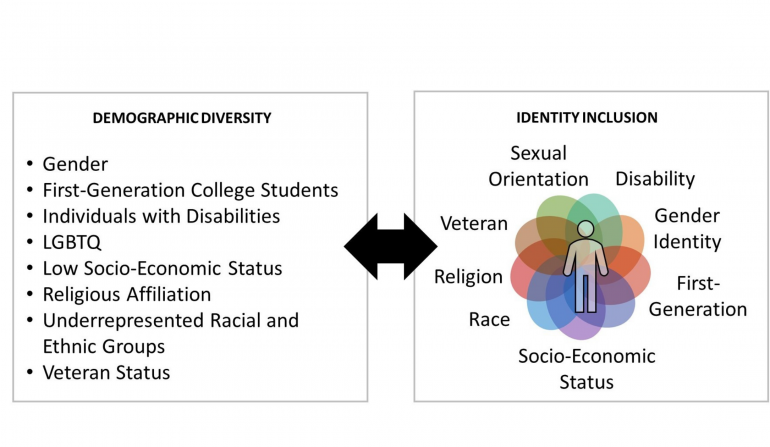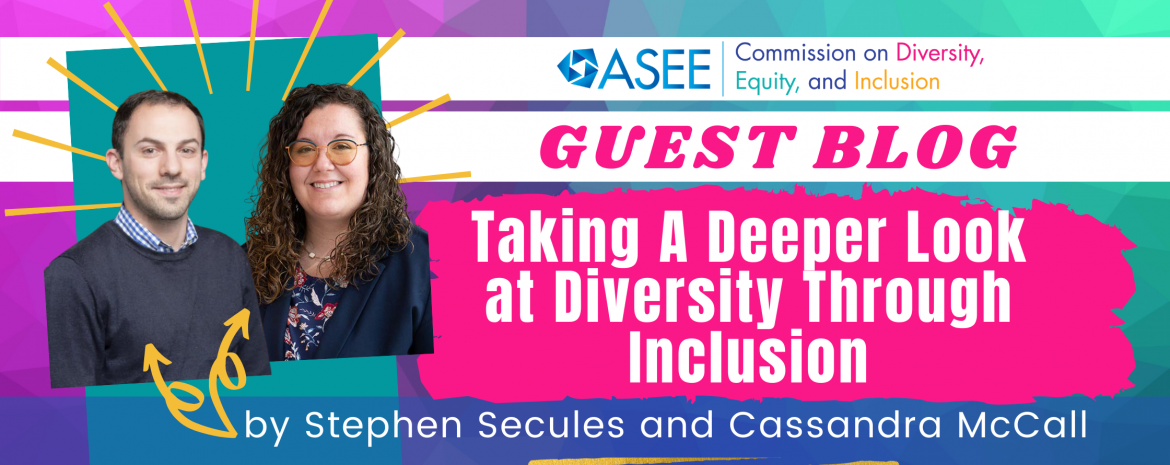Taking A Deeper Look at Diversity Through Inclusion
by Stephen Secules and Cassandra McCall
Have you ever walked into a meeting or event and thought— “Wow, there is a lot of diversity here”? What did you mean? Was the room full of people who seemed to be different from one another on the basis of race or gender? Or, did you have an expectation for who would be represented at the event; did the turnout seem to be less White than you anticipated? This is probably more or less our everyday way of approaching diversity: as a set of racial and gender categories, we can observe by looking around a room. This makes sense, as these visible markers of identity can map to important categories related to representation in engineering and in society.
But, what do we miss when we think about diversity as something an observer can easily determine by looking around a room? And, have you ever realized someone made an incorrect assumption about you? Have you made an incorrect assumption about someone else?
Even when we correctly perceive someone’s primary identity categories, we still cannot easily know the minoritized and marginalized experiences a person may carry with them.
There are complexities of diversity that move beyond what we can know by simply observing individuals. Most people tend to think about gender as a visible and binary marker of identity, but experiences and identities beyond the gender binary have highlighted the importance of giving individuals room to self-identify their pronouns. We also think about race as a visible set of discrete categories, but individuals have significant experiences of racial “passing” when their racial phenotype contrasts their background and identity. Other categories we might think of as “hidden identities” because we conceptualize them as less immediately visible than race and gender. These identities include aspects of sexual orientation, disability status, first-generation college student status, and low socioeconomic status, among others. It is often inappropriate and impossible to accurately guess someone’s sexual orientation or disability status as a simple observation.
Even when we correctly perceive someone’s primary identity categories, we still cannot easily know the minoritized and marginalized experiences a person may carry with them. If a student has received racial or sexual harassment one morning before class, or simply experiences stereotype threat through passive reminders that they are one of few from a deficit-associated identity category, we cannot simply observe these significant experiences solely from appearance. The hidden emotional and mental strains placed on students experiencing marginalization goes beyond affective or perspective-based differences– We are not talking about simply “diversity of thought”.

Figure: Reciprocal Relationship Among Dimensions of Diversity and Inclusion
Truly perceiving diversity requires deeper engagement with individuals both in our classrooms and in our research. It requires safe and inclusive environments that allow individuals to share private but significant aspects of self with others. As educators, this means we must intentionally create inclusive spaces and practices if we wish to understand the range of experiences in our classes and to be responsive to individual students. As researchers, we must do the work required to intentionally expand the rosters of our participants and prioritize marginalized voices as significant contributors to our field. Below, we provide some strategies that can be easily and immediately implemented to enhance the inclusion of engineering education teaching and research:
Strategies for Educators to Look Deeper into Their Classrooms:
- Utilize and prioritize syllabi indicators such as diversity statements, accommodations statements, and pronoun use. Position these as integral course components.
- Be informed of the support systems and policies for you and your students on your campus.
- Listen to your students when they come to you with concerns or questions; do not make assumptions regarding student experience.
- Integrate diversity, equity, and inclusion material into course content, even in technical-based and mathematically-oriented courses.
- Model the inclusive practices for your students such as including pronouns in your introduction and email signature.
- Utilize visible indicators of inclusive environments such as hanging a rainbow flag and Black Lives Matter signage in or outside your office.
Strategies for Researchers to Look Deeper Through Their Research:
- Develop accessible options for recruitment and data collection materials so that all participants can access material regardless of disability status and understand the language used to convey the research topic and procedures.
- Provide proactive signals of inclusivity such as allowing participants to write-in gender identification in a survey.
- Access groups that are typically not included in engineering education research such as participants from low-income areas or from institutions not typically included in research.
- Consider and interrogate current methods and frameworks used in diversity, equity, and inclusion research; do they reinforce systems of power and privilege?
- Promote research conducted with minoritized groups, particularly those that take inclusive research approaches by sharing work with colleagues and serving on review panels for funding agencies.
Strategies for the Community:
- Resist imposing meaning and identity onto others.
- Create space for individuals to identify identities for themselves.
- Affirm the socio-cultural factors that shape identity experiences.

Figure: Strategies for the Community
Read more about this topic in our prior work
Groen-McCall, C., McNair, L. D., Paretti, M. C., Shew, A., & Simmons, D. R. (2019, April). Experiencing undergraduate civil engineering education: The professional identity formation of two autistic undergraduate civil engineering students. Virginia Tech Autism Research Conference, Blacksburg, VA. https://blogs.lt.vt.edu/exploringidentity/publications/
Kali, M., Secules, S., McCall, C. (2020). Including Alice: Uncovering the Narrative of One Student’s Experience at the Intersection of International Student Status and Mental Health. Paper presented at 2019 CoNECD – The Collaborative Network for Engineering and Computing Diversity, Virtual conference.
McCall, C., Shew, A., Simmons, D. R., Paretti, M. C., & McNair, L. D. (2020). “Exploring student disability and professional identity: Navigating sociocultural expectations in U.S. undergraduate Civil Engineering programs.” Australasian Journal of Engineering Education, 25(1), 79-89. https://doi.org/10.1080/22054952.2020.1720434
Secules, S., & Groen-McCall, C. J. (2019, April), To Be or Not To Be: A Dialogic Discussion of Two Researchers’ Hidden and Transitioning Identities. Paper presented at 2019 CoNECD – The Collaborative Network for Engineering and Computing Diversity, Crystal City, Virginia. https://peer.asee.org/31799
Secules, S., Gupta, A., Elby, A., & Tanu, E. (2018). Supporting the narrative agency of a marginalized engineering student. Journal of Engineering Education, 107(2), 186-218. https://doi.org/10.1002/jee.20201
Secules, S., McCall, C., Mejia, J., Masters, A., Beebe, C., Sanchez-Peña, M., Svyantek, M. (in press). Positionality Practices and Dimensions of Impact on Equity Research: A Collaborative Inquiry and Call to the Community. Journal of Engineering Education.
Secules, S., & McCall, C. (2019). The Known Unknowns of Diversity & Inclusion: Supporting Individuals with Hidden & Transitioning Identities. https://digitalcommons.fiu.edu/succeed/2/
About the authors
Dr. Stephen D. Secules, Assistant Professor, SUCCEED, Florida International University
Follow the author: Twitter, LinkedIn
Short Bio: “I am an Assistant Professor in Engineering Education at Florida International University. I have degrees in engineering and acoustics, and a PhD in education focused on culture and equity in engineering education. In my work, I use critical qualitative, video-based, participatory, and ethnographic methods to look at everyday educational settings in engineering and shift them towards equity and inclusion. I have ongoing projects related to critical analysis of dominant cultural norms in classroom spaces, and alternative dissemination approaches for qualitative research.”
Dr. Cassandra McCall, Assistant Professor, Engineering Education, Utah State University
Follow the author: LinkedIn
Short Bio: “I am a visually-impaired Assistant Professor in the Engineering Education Department at Utah State University. I have bachelor’s and master’s degrees in Civil Engineering and a PhD in Engineering Education. In my work, I use grounded theory and other emergent qualitative approaches to explore the interactions among disability and professional identity formation and dominant engineering and academic cultures. My current work includes an NSF-funded project exploring the professional identity formation of undergraduate civil engineering students with disabilities.”
Do you want to become a guest blogger?
CDEI Guest Blog highlight future events, describe best practices, or share calls to action by CDEI members. We invite you to propose posts that share brief research highlights, reports of impactful initiatives, critical thought pieces, and resources you find useful. We especially encourage emerging scholars to share their work. If you are interested in sharing a blog or resource post, you may submit your proposal here. All posts are screened and edited.

